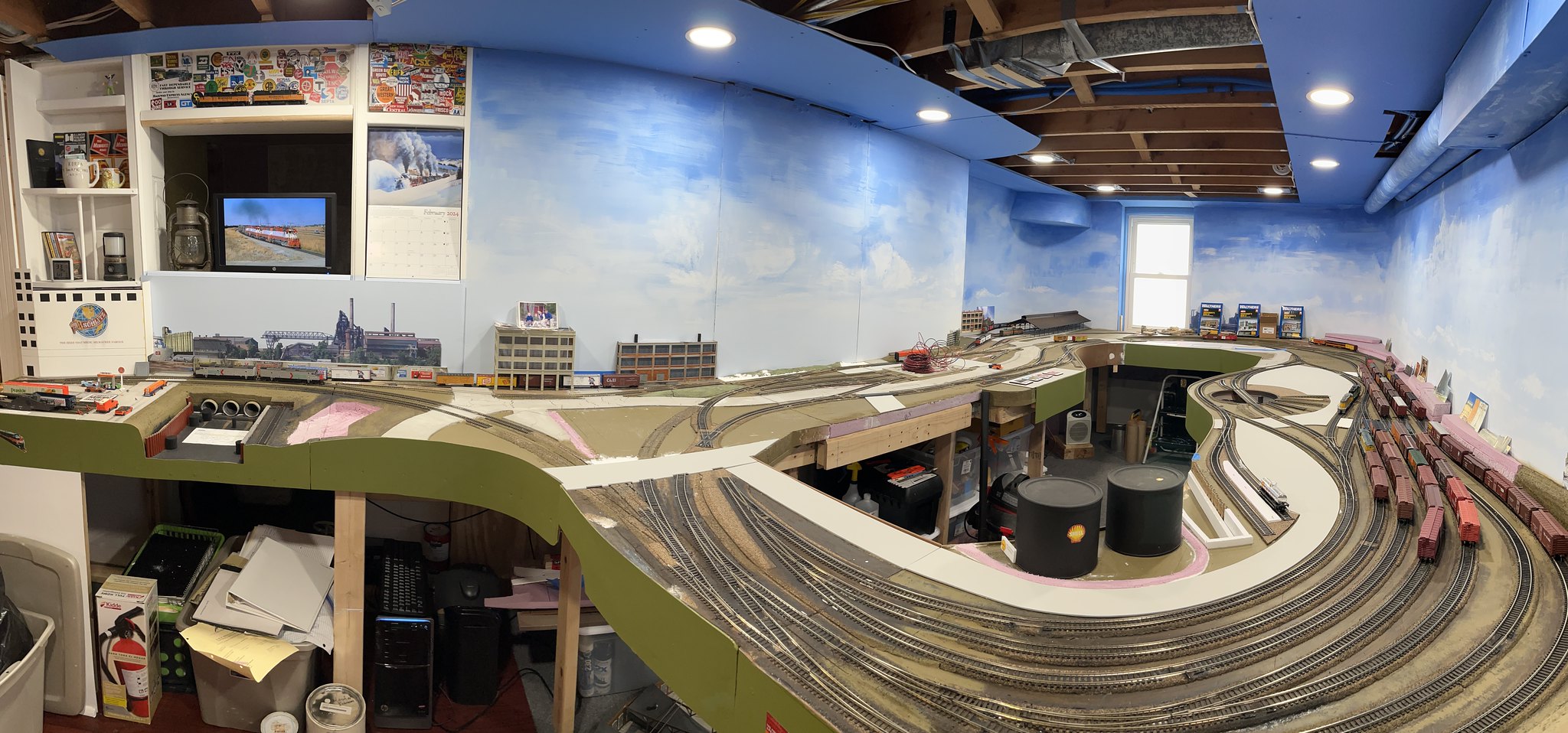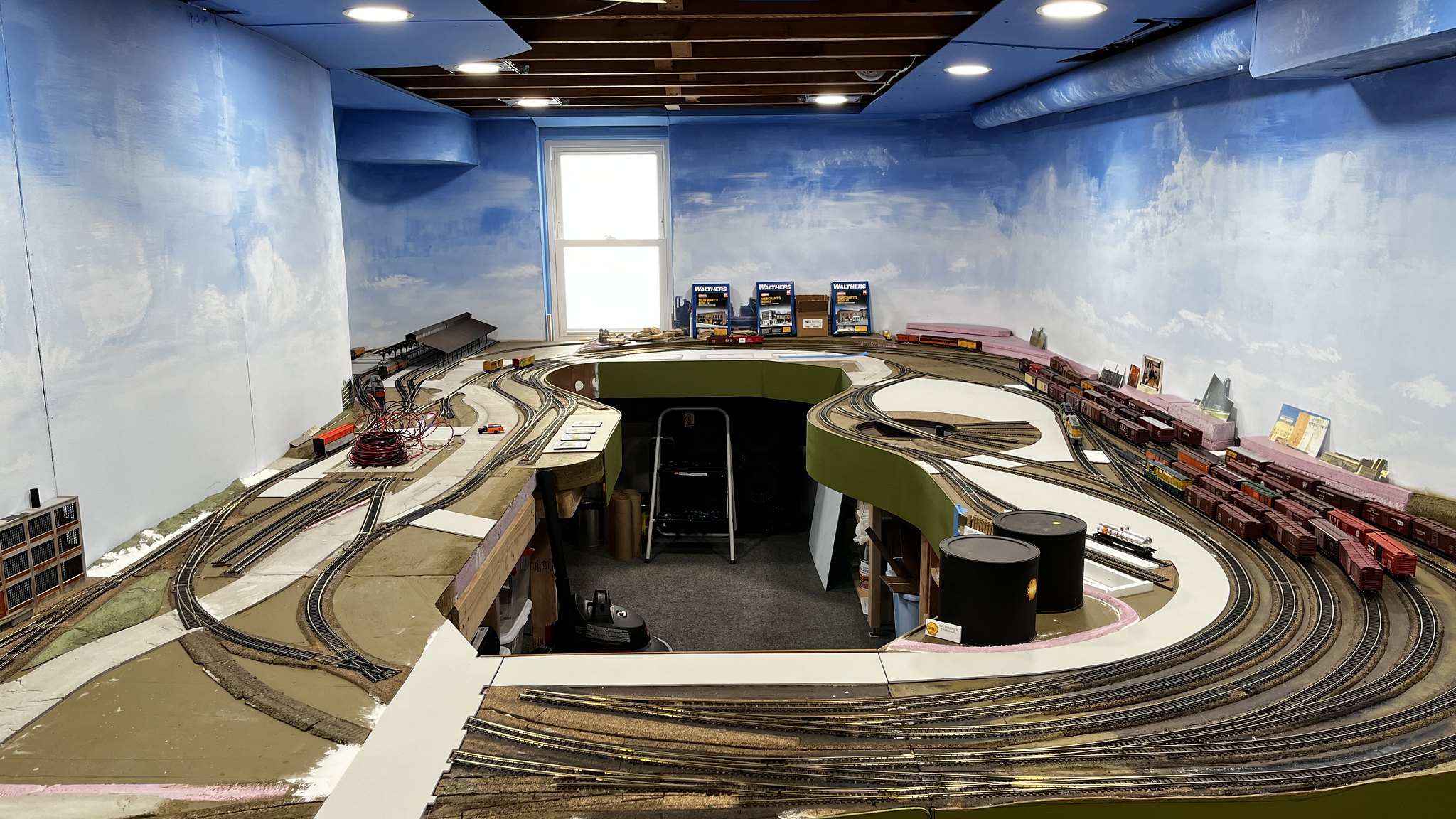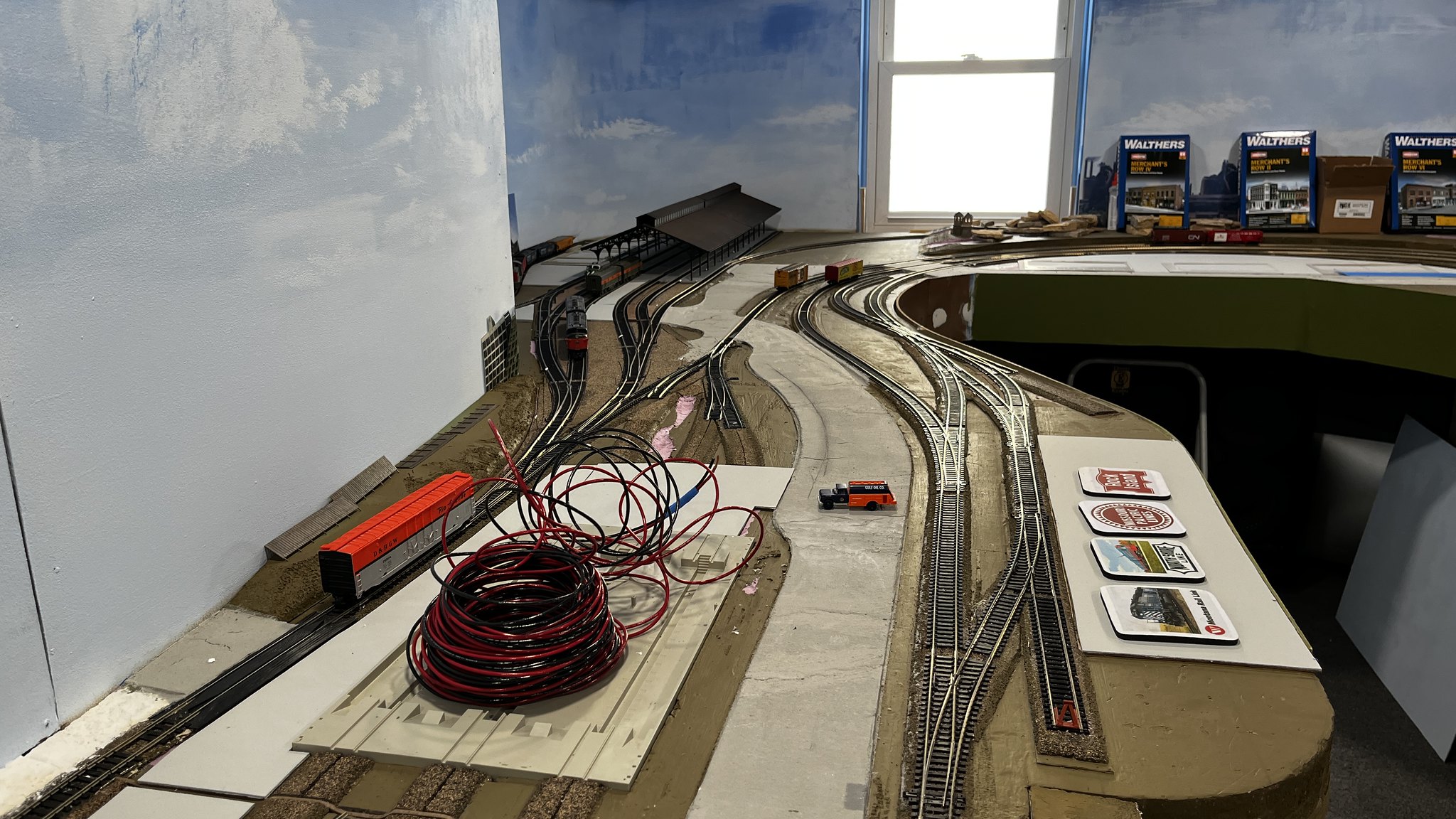Has anyone done this? I hear that you can just trim off the ends and strip out the individual wires to use as feeder drops. I’m guessing this would be something like 24/2. The feeder wires provided in my NCE wiring kit are going to be too short in many cases at only 18" long.
I use 22 gauge speaker wire, no longer than 12" in length to the buss wire. It appears that CAT6 is 23 gauge, so, I don’t see why it wouldn’t work. Why are you running feeder wires longer than 18"? The smaller the wire, the longer the run, the less juice at the end.
Thanks, Terry
Yep, I wondered the same thing. I run my buses right under my track.
Rich
I suppose bc I was trying to limit how much I have to snake the main buss back and forth across the layout underside: I have a relatively dense track layout so I was planning to run the main buss more or less down the middle of my deck underside (which varies from about 24" to 36" deep around the walls), then install terminal strips in spots for feeder connections.
Even if I center the main buss under the double main (which isn’t centered in my benchwork but at times runs along the back edge, splits apart, runs near the front edge), I will need more than 6-12" to reach trackage along the back or front faces - especially in my yard area.
While visiting a KC hobby shop last month I looked under their layout and saw CAT cable feeder wires of various lengths running to terminal strips spaced periodically. Some of the feeders were easily 2 - 3’ long, maybe even longer in places.
I use 22 gauge copper stranded wire for feeders. Cat 6 Ethernet cable is 23 gauge, slightly smaller than 22 gauge, so I don’t see why they won’t work with 18" long feeders. As the feeder length gets longer than 18", I would be inclined to use a heavier gauge such as 20 gauge.
Rich
I will attempt to upload some photos of the layout below showing the overall site:
 Layout Update Feb 2024 by The Milwaukee Road Warrior, on Flickr
Layout Update Feb 2024 by The Milwaukee Road Warrior, on Flickr
 Layout Update Feb 2024 by The Milwaukee Road Warrior, on Flickr
Layout Update Feb 2024 by The Milwaukee Road Warrior, on Flickr
In the photo below, one main is to the left with the Rio Grande box car sitting on it, the other main has split around the diesel house and is just right of the Gulf Oil gas truck on the road.
 Layout Update Feb 2024 by The Milwaukee Road Warrior, on Flickr
Layout Update Feb 2024 by The Milwaukee Road Warrior, on Flickr
That makes sense. As you can probably see from the photos, I have places where feeders will be longer: the yard for example.
In addition, I have mostly Peco insulfrog turnouts and from my research I’ve basically gathered that the only fool-proof way to make sure I don’t have dead spots is to power all three legs of my turnouts. This will require a lot of feeders, all over the place given the track arrangement.
As it would be impracticle to snake the main buss to within 6-12" of all of these locations, I’m going to more or less make a simple oval run around the layout with the buss as close as possible to the mains. In the yard/roundhouse area which is wider (nearly 36" deep) I will probably end up with some 18" long + feeders no matter where I place my terminal strips. I will plan to use larger gauge wire (20) per your suggestion. Thanks.
OK, just the experiance of the DC, guy. Back in the day my father wired the whole layout with 24 gauge telephone station wire - never any issues (the layout was 18’ x 5’)
I prefer solid wire for connections to the rail much easier to solder in place and much easier to attach to terminal blocks.
I use c
Hello Andy,
That’s a pretty nice looking layout. I can see why some of your feeders may exceed 12" run.
Why not run some feeder wires to what you think is going to be the maximum length (worst case scenario) and do a quarter test and see if your short circuit protection kicks in?
Terry
Andy.
How about sub bus. Branches of buss wire off the main buss. Or what I have done and still do is 22 AWG through the base board soldered to a piece of 16 or 14 AWG on to the 10 AWG buss lines. This way the maximum length of 22AWG is less than 6 inches.
The main reason for short feeders is not only voltage loss but really protection from over heating. It’s possible to over heat a feeder when a short happens and the breaker doesn’t see the short fast enough. A delay in the tripping of a circuit breaker can actually ruin a decoder or cause other problems besides glowing wires and burnt insulation. On a layout such as yours. Five amps through a long thin wire is a gamble in my opinion. I also solder every connection. Some like those suitcase connectors. But look at the little blade inside them. Do you really trust 5 to 10 amps to reliably flow through a knife edge.
Pete.
Pete.
One ‘advantage’ to using old Ethernet cable is that the inner conductors offer eight choices for color coding.
If you are concerned with 23ga. being a bit too fine, just double the run except for the last inch up to the soldering point on the rail. (I would not leave the two wires as a ‘twisted pair’ unless you want them to stay neat together.)
I should note that I only have an NCE Powercab. I’m starting to wonder if that will even put out enough juice for this amount of track.
Thanks for throwing that out there: I’m curious about the sub buss but I guess I don’t know how it works. Does the main buss need to complete a circuit back at my Powercab throttle plug-in? Or can I wire the main in branches like tree roots? (And don’t even get me started on wiring thru my two lift sections…)
Every time I think I have figured something out, it gets more complicated. If I were planning to build multiple layouts in my life I wouldn’t sweat it too much, but this is IT. I plan to do it one time and be done. So I feel the pressure to do it right the first time and not burn my house down.
(Rant)
BY FAR the most frustrating aspect of the last 4 years has been the electrical. That’s why you see aspects of scenery and building partially completed in my pictures: rather than get bogged down and make no progress while I try to figure out how to wire this thing, I just pivot to other projects. At least I keep moving forward that way.
Problem is, you can only do that for so long. I have to face the wiring eventually. Or soon I will have the nicest looking layout that has no power to run trains.
I’m a learner by seeing with electronics/electrical and I’m getting to the point where I’m tempted to give in and hire someone.
I’ve read so many different things my brain is just mush at this point. People say look at so and so’s web site, or watch so and so on YouTube .
Given the size of your layout, which is very nice by the way, you might consider adding a 5 amp booster, using the Power Cab as a walk around throttle.
Also, it would make good sense to wire all three ends of every turnout.
Rich
[quote user=“The Milwaukee Road Warrior”]
wrench567
Andy.
How about sub bus. Branches of buss wire off the main buss. Or what I have done and still do is 22 AWG through the base board soldered to a piece of 16 or 14 AWG on to the 10 AWG buss lines. This way the maximum length of 22AWG is less than 6 inches.
I should note that I only have an NCE Powercab. I’m starting to wonder if that will even put out enough juice for this amount of track.
Thanks for throwing that out there: I’m curious about the sub buss but I guess I don’t know how it works. Does the main buss need to complete a circuit back at my Powercab throttle plug-in? Or can I wire the main in branches like tree roots? (And don’t even get me started on wiring thru my two lift sections…)
Every time I think I have figured something out, it gets more complicated. If I were planning to build multiple layouts in my life I wouldn’t sweat it too much, but this is IT. I plan to do it one time and be done. So I feel the pressure to do it right the first time and not burn my house down.
(Rant)
BY FAR the most frustrating aspect of the last 4 years has been the electrical. That’s why you see aspects of scenery and building partially completed in my pictures: rather than get bogged down and make no progress while I try to figure out how to wire this thing, I just pivot to other projects. At least I keep moving forward that way.
Problem is, you can only do that for so long. I have to face the wiring eventually. Or soon I will have the nicest looking layout that has no power to run trains.
I’m a learner by seeing with electronics/electrical and
Given the size and complexity of the layout, having the layout broken down into power districts with circut breakers would be an advantage.
If you were to add a booster, I would put it under the layout where that step stool is sitting and run your bus wires to the left and to the right, directly under the mainlines instead of an oval bus.
Then, I would create one or more power districts, each controlled by a circuit breaker. One location for a power district would be that turntable complex including the approach tracks.
Rich
duplicate post
Andy.
I’m sorry if you misunderstood. I don’t chop my buss wires. I have a pair of wire strippers that grabs the insulation and pulls it apart about an inch. I think some people call them automatic strippers. And another thing is that my layout is modular and the longest span is 6 feet.
It’s not the size of the layout. It’s the load that’s put on your Power Cab. Four or five sound equipped locomotives will probably tax it. Luckily there are multiple ways to upgrade. But that is another discussion for later.
Your buss should not loop and attach together. You run the risk of echoes and cross talk in the digital wave form. I’ve been wiring DCC for decades. There has been loads of suggestions for running buss lines. From keeping them separated at least 6 inches to twisting them together. The only right way is to make sure you have solid connections and do a quarter test on each piece of rail.
Pete
[quote user=“The Milwaukee Road Warrior”]
I should note that I only have an NCE Powercab. I’m starting to wonder if that will even put out enough juice for this amount of track.
Thanks for throwing that out there: I’m curious about the sub buss but I guess I don’t know how it works. Does the main buss need to complete a circuit back at my Powercab throttle plug-in? Or can I wire the main in branches like tree roots? (And don’t even get me started on wiring thru my two lift sections…)
Every time I think I have figured something out, it gets more complicated. If I were planning to build multiple layouts in my life I wouldn’t sweat it too much, but this is IT. I plan to do it one time and be done. So I feel the pressure to do it right the first time and not burn my house down.
(Rant)
BY FAR the most frustrating aspect of the last 4 years has been the electrical. That’s why you see aspects of scenery and building partially completed in my pictures: rather than get bogged down and make no progress while I try to figure out how to wire this thing, I just pivot to other projects. At least I keep moving forward that way.
Problem is, you can only do that for so long. I have to face the wiring eventually. Or soon I will have the nicest looking layout that has no power to run trains.
I’m a learner by seeing with electronics/electrical and I’m getting to the point where I’m tempted to give in and hire someone.
I’ve read so many different things my brain is just mush at this point. People say look at so and so’s web site, or watch so and so on YouTube …where I realize there are even MORE things I should be incorporating like circuit protection: should I buy NCE breakers? Wire in lightbulbs? I don’t know how to even use a rrampmeter or test for shorts. I’ve never soldered IN MY LIFE.
First I w
Where are those two lift sections?
Rich